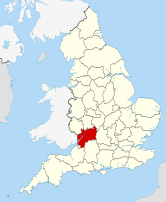Cirencester Abbey
Cirencester Abbey or St Mary's Abbey, Cirencester in Gloucestershire was founded as an Augustinian monastery in 1117 on the site of an earlier church, the oldest-known Saxon church in England, which had itself been built on the site of a Roman structure. The church was greatly enlarged in the 14th century with addition of an ambulatory to the east end. The abbot became mitred 1416. The monastery was suppressed in 1539 and presented to Roger Bassinge.
In the twelfth and thirteenth centuries, the abbey fostered the successful writers Robert of Cricklade and Alexander Neckam. They were supported in their work by other canons, including Walter de Melida and Alexander's nephew Geoffrey Brito.
Post Dissolution
A house called Abbey House was built on the site in the late 16th century, remodelled in the 1780s, and then demolished in 1964 to be replaced by a block of flats. The area that contained the nucleus of the monastery is now a public park, and only the Norman Arch, an original gateway to the abbey, and parts of the precinct wall remain above ground.
The impressive and substantial three-storey porch of the parish church was built as an administrative building of the abbey and after 1539 the upper levels were used for some time as the town hall. The church itself is a relic and product of a long-standing feud between the townspeople and the abbey. The latter, who were responsible for the chancel of the parish church have left us with a plain and unadorned building. The townspeople however were responsible for the remainder, and rebuilt the nave and west tower in an impressive style so as to far out-do the canons and at least win in a war of architecture if nothing else.
Bibliography
- Fuller, E.A. "The Parish Church of St. John the Baptist, Cirencester". Transactions of the Bristol and Gloucestershire Archaeological Society. 17: 34–44.
- Fuller, E.A. "The Register of the Chapel of the Blessed Virgin Mary, in the Parish Church of Cirencester". Transactions of the Bristol and Gloucestershire Archaeological Society. 18: 320–331.
- Rollison, David (2011). Commune, country and commonwealth: The people of Cirencester, 1117–1643. Studies in Early Modern Cultural, Political and Social History. Woodbridge, Suffolk: Boydell Press. ISBN 978-1-84383-671-1.
- Fuller, E.A. "Tenures of land, by the customary tenants, in Cirencester". Transactions of the Bristol and Gloucestershire Archaeological Society. 2: 285–319.
- Fuller, E.A. (1932). "Medieval Cirencester". Transactions of the Bristol and Gloucestershire Archaeological Society. 54: 107–115.
- The cartulary of Cirencester Abbey, Gloucestershire. C.D. Ross, Mary Devine (eds.). London: Oxford University Press. ISBN 0-19-711637-X.
{{cite book}}: CS1 maint: others (link) - Evans, A.K.B. (1991). "Cirencester abbey: The first hundred years". Transactions of the Bristol and Gloucestershire Archaeological Society. 109: 99–116.
- Evans, A.K.B. (1976). "The collegiate church at Cirencester: a critical examination of the historical evidence". Studies in the archaeology and history of Cirencester: Based on papers presented to a research seminar on the post-Roman development of Cirencester held at the Corinium Museum, November 1975. British Archaeological Reports, British Series. Oxford: British Archaeological Reports. pp. 46–60.
{{cite book}}: Unknown parameter|editors=ignored (|editor=suggested) (help) - Fuller, E.A. "Cirencester: The manor and the town". Transactions of the Bristol and Gloucestershire Archaeological Society. 9: 298–344.
- Evans, A.K.B. (1989). "Cirencester's early church". Transactions of the Bristol and Gloucestershire Archaeological Society. 107: 107–122.
- Reece, Richard (1962). "The Abbey of St Mary, Cirencester". Transactions of the Bristol and Gloucestershire Archaeological Society. 81: 198–203.
- Evans, A.K.B. (1993). "Cirencester abbey: from heyday to dissolution". Transactions of the Bristol and Gloucestershire Archaeological Society. 111: 115–142. ISSN 0068-1032.
- Wilkinson, David J. (1998). "The Augustinian abbey of St Mary". Cirencester Anglo-Saxon church and medieval abbey. Cirencester excavations. Cirencester: Cotswold Archaeological Trust. pp. 43–66. ISBN 978-0-9523196-2-7.
{{cite book}}: Unknown parameter|editors=ignored (|editor=suggested) (help) - Fuller, E.A. "Cirencester Abbey Church". Transactions of the Bristol and Gloucestershire Archaeological Society. 17: 45–52.
- Victoria County History, Gloucestershire, Vol.2, 1907, pp.79-84, The Abbey of Cirencester
References
- New, Anthony. A Guide to the Abbeys of England and Wales. London: Constable. pp. 113–114.
- Platt, Colin. The Travellers Guide to Medieval England. London: Secker & Warburg. pp. 110–112.


